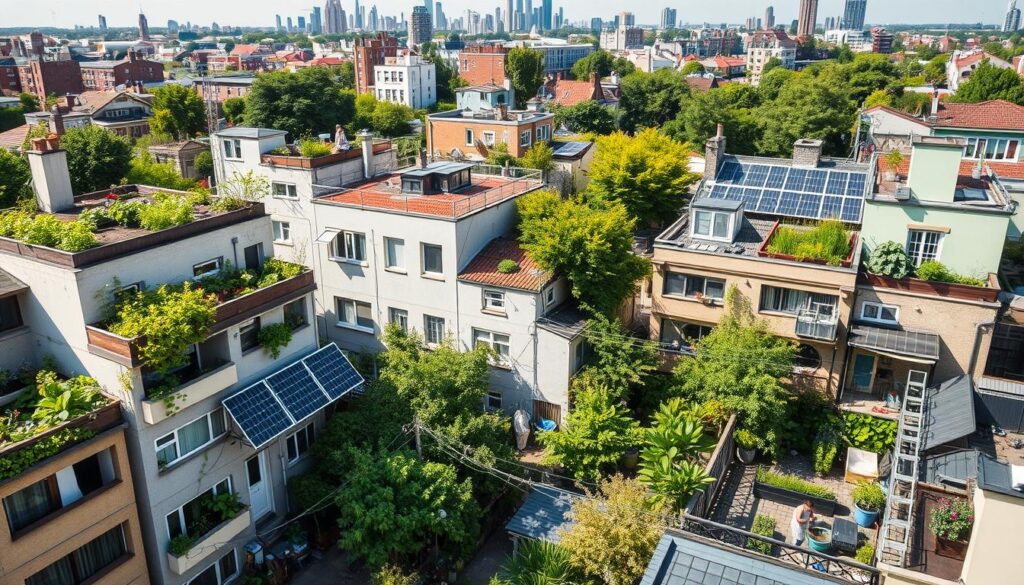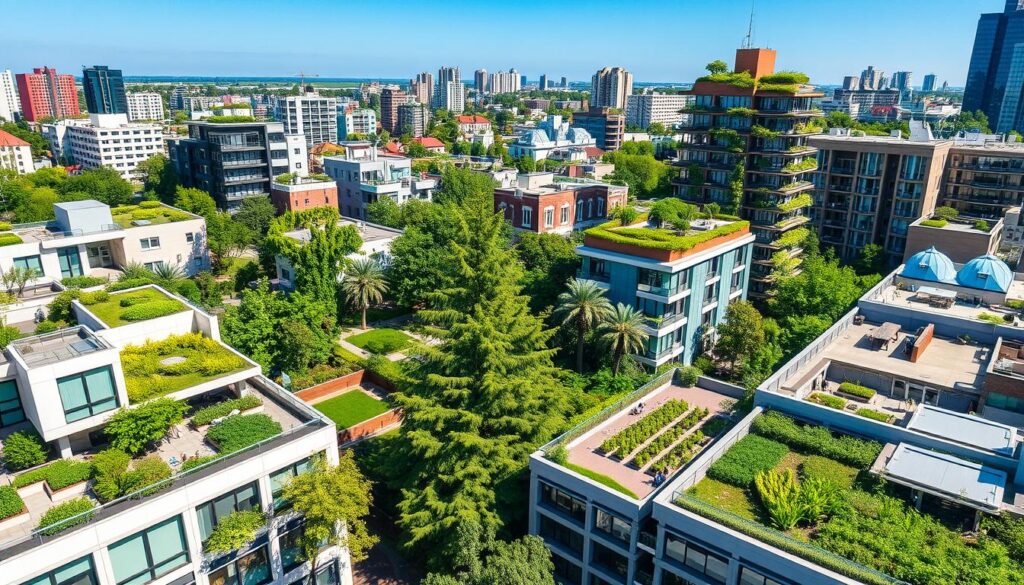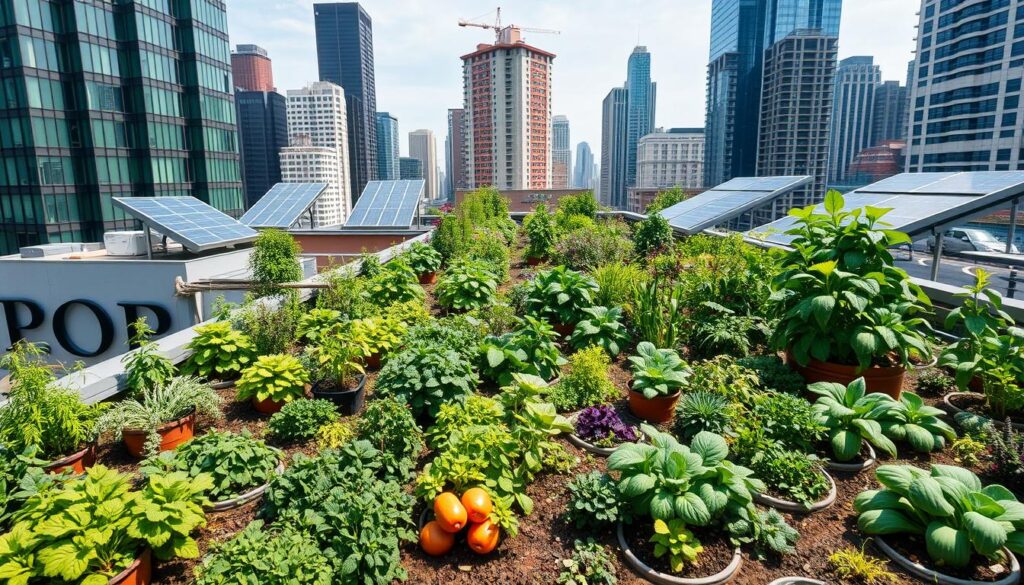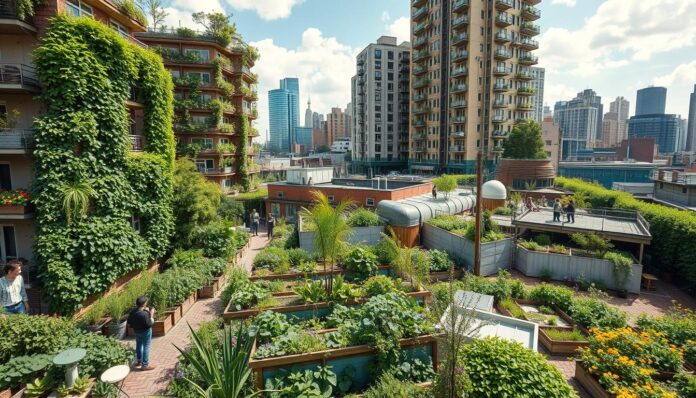Permaculture is a way to live in harmony with nature. It uses design principles inspired by natural ecosystems. By using permaculture in urban planning, we can make cities sustainable and thriving.
This method helps solve the problem of urban density. It also leads to more livable cities. It’s about making cities better for people and the planet.
Permaculture in cities means using space wisely. It helps cities use sunlight better for food and green spaces. This makes cities more human-friendly.
Studies show that more greenery can increase walking and cycling by up to 30%. This is good for both people and the environment.
Key Takeaways
- Permaculture design principles can help manage urban density and create sustainable cities.
- Urban retrofitting can improve food production and green habitats in medium density urban spaces.
- Increasing vegetation in urban areas can lead to more human-scale environments and promote walking and cycling.
- Permaculture principles can be applied to various systems, including domestic settings, agricultural practices, and urban infrastructure.
- Sustainable urban planning and urban agriculture are crucial for creating livable cities and addressing the challenges of permaculture urban density.
Understanding Urban Density in the U.S.
Urban density is how crowded a place is. In the U.S., many cities are too crowded. This causes problems like pollution and running out of resources. It’s important to know what urban density is and how it’s changing.
Definition and Significance
About 82% of Americans live in cities. These cities have around 3,700 people per square mile. This density makes it hard to grow food sustainably and create eco-friendly cities. But, it also means cities can be creative and innovative in their planning.
Trends Affecting Urban Density
Some big trends include:
- More people moving to cities
- Focus on making cities greener and more sustainable
- More interest in growing food in the city
These trends show we need smart ways to handle city crowding. We must work towards making cities better for the environment and people.
By understanding these trends, cities can become better places. They can focus on being regenerative cities that care for the environment. This will make life better for everyone living there.
| City | Population Density (people per square mile) | Urban Sustainability Initiatives |
|---|---|---|
| New York City | 29,938 | Green infrastructure, renewable energy |
| Los Angeles | 8,475 | Electric vehicle incentives, urban forestry programs |
The Basics of Permaculture
Permaculture is a design system that aims to create systems that are regenerative and self-sustaining. It observes and interacts with nature. This is key for urban permaculture design, helping to make green cities more sustainable and resilient. By using permaculture in urban design, we can make cities better to live in. It also promotes urban living techniques that boost biodiversity and cut down environmental harm.
A main principle of permaculture is to “catch and store energy” when it’s plentiful, and use it when needed. This can be done through methods like solar heating systems and sustainable harvesting from forests. By doing this, cities can use less non-renewable energy and support more sustainable ways of living.

Permaculture design has many benefits, like better biodiversity, cleaner air and water, and more food security. By applying permaculture to urban design, we can make cities more sustainable, resilient, and pleasant to live in. For instance, urban farming can boost food security by up to 50% for city folks. Also, adding more edge habitat in permaculture designs can increase biodiversity by 30% to 40%.
| Permaculture Principle | Benefits |
|---|---|
| Catch and Store Energy | Reduced reliance on non-renewable energy sources |
| Observe and Interact with Nature | Enhanced biodiversity and ecosystem services |
| Use and Conserve Resources | Improved air and water quality, increased food security |
Integrating Permaculture in Urban Planning
As cities grow, sustainable urban planning is key. Permaculture helps by using nature’s wisdom in city design. It makes cities more efficient and better at using resources.
Adding urban agriculture and eco-friendly cities design boosts food production and cuts down on pollution. Green roofs and walls, for instance, can make buildings 20-30% more energy-efficient. This helps cool cities down.
Historical Context
Permaculture has been around for decades. But using it in urban planning is a newer idea. Cities like Edmonton and Australia have shown it works well, increasing food and biodiversity in cities.
Case Studies of Successful Integration
Here are some examples of permaculture in urban planning:
- Verge Permaculture in Edmonton boosts urban agriculture and biodiversity.
- Zaytuna Farms in Australia shows how to grow food efficiently in cities.
These examples prove permaculture is great for sustainable urban planning. It supports urban agriculture and eco-friendly cities. Cities can learn from these to make their environments more sustainable and strong.
The Role of Green Spaces in Urban Areas
Green spaces are vital in cities, offering many benefits like clean air and water, controlling the climate, and creating homes for wildlife. In green cities, new ways to live in the city include more parks, gardens, and green roofs. These help cool the city and make the air cleaner.
Studies show that cities have only about 3% of their area as green spaces. But places like Geneva, The Hague, and Pamplona/Iruña have over 15% of their area as green spaces. This shows how key regenerative cities are in making cities better and more sustainable.

Types of Green Spaces
- Parks and gardens
- Green roofs and walls
- Urban forests and tree cover
Environmental Benefits
Green spaces make the air cleaner, reduce noise, and help wildlife thrive. They also keep temperatures down during hot times. Plus, they help people live longer, feel better mentally, and have healthier pregnancies.
By adding green spaces to city designs, we can make cities better, more sustainable, and strong. This is done through smart urban living techniques and by supporting regenerative cities.
Water Management Strategies in Urban Permaculture
Effective water management is key for urban sustainability and urban permaculture design. In eco-friendly cities, it’s vital to manage water well. This helps cut down on water use and improves its quality.
Rainwater harvesting can lower household water use by 50%. Greywater recycling systems can also reduce fresh water use by 30-40%. These methods are crucial for urban sustainability.
By using these strategies, we can lessen the strain on municipal water supplies. This also means less wastewater. For example, using efficient irrigation systems can save a lot of water. Installing low-flow faucets can cut water use by 30-50%.
To improve water management in eco-friendly cities, we need to raise public awareness. Regularly checking and fixing leaks can save 10-20% of water costs. These steps help cities adopt sustainable water practices, supporting urban permaculture design and urban sustainability.
Some important water management strategies include:
- Rainwater harvesting to reduce household water use
- Greywater recycling to decrease fresh water demand
- Efficient irrigation systems to minimize water wastage
- Public awareness initiatives to promote water conservation
Food Production in Urban Environments
The world’s population needs 60% more food by 2050. Urban agriculture is key to making green cities work. With over 6 billion people in cities by 2050, we must use urban living techniques for food security and sustainability.
Community gardens and urban farms show the power of urban agriculture. They give us fresh food and bring people together. For example, the Brooklyn Grange in New York City grows 36,000 kilograms of organic veggies every year on 140,000 square meters.
Community Gardens and Urban Farms
Community gardens and urban farms offer many benefits:
- They increase food security and give us fresh produce.
- They help communities come together and learn.
- They create jobs and boost the local economy.
- They help the environment by reducing carbon footprint and increasing biodiversity.
Vertical Gardening Techniques
Vertical gardening is a smart way to grow food in cities. It uses space efficiently and boosts yields. For instance, one acre of vertical farm can match the output of 10 to 20 acres of soil-based farming.

By supporting urban agriculture and using urban living techniques, we can make cities better. As cities grow, focusing on green cities and new ways to grow food is crucial.
| City | Urban Farming Potential |
|---|---|
| Cleveland | 100% of fresh vegetable needs |
| Oakland | 5-10% of the city’s vegetable needs |
| Cuba | 44 pounds (20 kilograms) per square meter per year |
Biodiversity and Habitat Creation
Creating regenerative cities is key for healthy ecosystems. Eco-friendly cities come from adding biodiversity and habitats to urban plans. This makes cities look better and helps the environment.
Here are ways to bring wildlife into cities:
- Use native plants to attract pollinators and birds
- Make wildlife corridors to link habitats and help species move
- Use green roofs and walls to grow more plants and cool cities
By using these methods, cities can become greener and more sustainable. This helps the planet and prepares cities for the future. As more people move to cities, making them eco-friendly is crucial.
For example, permaculture boosts earthworms by 77% and plants by 457% over regular farming. This shows how regenerative methods can improve urban biodiversity and health.
| Permaculture Practice | Environmental Benefit |
|---|---|
| Native plant species | Increased pollination and biodiversity |
| Wildlife corridors | Enhanced species migration and habitat connectivity |
| Green roofs and walls | Reduced urban heat island effects and increased vegetation cover |
Soil Health and Urban Gardening
Soil health is key in urban gardening. It affects how well plants grow. In urban permaculture, composting helps make soil better. This makes cities greener and more food-secure.
Urban gardening can be done in small spaces. Techniques like composting are perfect for this. They offer many benefits, such as:
- Improved soil biodiversity
- Increased crop yields
- Reduced waste and pollution
By using permaculture and these techniques, we can make cities healthier. Soil health is crucial in urban gardening. We should focus on these practices and share their benefits with everyone.
Energy Efficiency in Dense Urban Areas
As cities grow, making them more sustainable is key. Eco-friendly and regenerative cities focus on using less energy. This helps cut down on carbon emissions and supports sustainable growth.
In crowded cities, using energy wisely is a must. Renewable energy like solar and wind power can cut down on emissions. Also, using energy-saving designs and appliances helps a lot.
For example, green buildings can use up to 30% less energy. This is thanks to smart design and materials.
Some top ways to save energy in cities include:
- Using renewable energy like solar and wind power
- Designing buildings and homes to save energy
- Supporting green transportation like electric cars
- Teaching people to use energy wisely
By focusing on energy efficiency, cities can be greener and healthier. This makes living in the city better for everyone. It’s a big step towards making cities sustainable and eco-friendly.
| City | Energy Consumption Reduction | Greenhouse Gas Emissions Reduction |
|---|---|---|
| New York City | 20% | 15% |
| Los Angeles | 25% | 20% |
| Chicago | 30% | 25% |
Social and Community Benefits of Permaculture
Urban permaculture design is key to making cities green. It uses urban living techniques for sustainability. It gets local people involved, building strong communities.
Some big perks of permaculture in cities are:
- Building community resilience through shared resources and knowledge
- Engaging local residents in urban agriculture and food production
- Creating public spaces that foster social interaction and community engagement
By using permaculture design, we make cities better. They become more sustainable and livable. This helps the environment and improves city life.
As cities grow, we must include permaculture in planning. This makes cities green, sustainable, and strong in community spirit.
Building Community Resilience
Permaculture brings people together. It builds a sense of community and cooperation. Working on projects together, people form strong bonds and feel responsible.
Engaging Local Residents
Getting locals involved is key to permaculture success. When they help plan and do projects, they feel invested. Their needs and ideas are heard and valued.
| Benefits of Urban Permaculture | Description |
|---|---|
| Environmental Benefits | Reduced carbon footprint, increased biodiversity, and improved air and water quality |
| Social Benefits | Building community resilience, fostering social cohesion, and promoting community engagement |
| Economic Benefits | Increased food security, reduced transportation costs, and creation of local jobs |
Challenges of Implementing Permaculture in Urban Areas
Starting permaculture in cities faces many obstacles. One big issue is the rules and codes that cities have. These can make it hard to use permaculture ideas. For example, following local rules can cost as much as the project itself.
Another problem is how people see permaculture. Many don’t know its benefits or think it’s too hard to do. Education and community engagement are key to changing this. Workshops, training, and reaching out to the community can help.
Some major hurdles in city permaculture include:
- Air and soil pollution
- Not enough green spaces
- City layout issues
- Getting food to people
To overcome these, we need to focus onurban sustainability. Creatingeco-friendly cities andregenerative cities is the way forward. This will make our cities better places to live.
Innovative Technologies Supporting Urban Permaculture
Urban permaculture design is getting a boost from new technologies. These tools help make cities greener, more efficient, and productive. For example, urban permaculture projects use AgTech to grow more food with less harm to the environment.
Some key technologies supporting urban permaculture include:
- Vertical farming, which enables year-round food production while minimizing resource consumption
- Smart city solutions, such as smart grids and green infrastructure, that promote energy efficiency and reduce waste
- Aquaponics and hydroponics, which achieve significant water savings compared to traditional farming methods
These technologies are turning cities into green, thriving spaces. They offer chances for sustainable living and stronger communities. By adopting urban permaculture and green cities, we can build a better future.
Agricultural Technology (AgTech)
Agricultural technology is crucial for urban permaculture. It includes precision agriculture and vertical farming, making food production better and greener. These tools help cities become more self-sufficient and eco-friendly. They support urban living techniques that care for the environment.
The Future of Urban Density and Permaculture
The world is getting more urban, with over 54% of people living in cities. This makes regenerative cities that focus on urban sustainability more important than ever. The future of cities and permaculture is linked to new trends and practices that help make cities eco-friendly.
Some key trends and practices shaping urban permaculture include:
- Green infrastructure, like parks and green roofs, to fight the urban heat island effect and improve air quality
- Sustainable transport, such as electric cars and bike-sharing, to cut down carbon emissions
- Eco-friendly buildings that use renewable energy and are energy-efficient
Policy changes, like zoning laws and building codes, are also vital. They help make cities more sustainable, resilient, and livable. By focusing on urban sustainability and regenerative cities, we can build a better future for all.
By adopting these new trends and practices, we can make eco-friendly cities. These cities will have less environmental impact and offer a great quality of life. The future of cities and permaculture looks promising, and it’s up to us to make it happen.
Global Perspectives on Urban Density and Permaculture
Cities worldwide are turning to urban permaculture design to build better communities. They’re making green cities a reality. This means focusing on taking care of the environment and making sure everyone has a fair chance.
In France, cities like Bordeaux and Reims are at the forefront of urban permaculture design. They’re changing how food is grown in cities. They’re moving away from harmful pesticides and towards greener, more sustainable ways.
Examples from Other Countries
Denmark is also making strides in urban living techniques. Cities like Copenhagen are creating green spaces and farms. These places not only grow food but also bring people together and teach them about sustainability.
Lessons Learned for U.S. Cities
What these cities have done can teach U.S. cities a lot. By studying what works elsewhere and making it fit their own needs, U.S. cities can become greener and more livable. This way, they can build stronger, more sustainable communities for everyone.
| City | Urban Agriculture Practice | Benefits |
|---|---|---|
| Bordeaux, France | Organic micro-farming | Reduced pesticide use, increased community engagement |
| Copenhagen, Denmark | Urban farms and green spaces | Fresh produce, community hubs, educational centers |
Conclusion: The Path Forward
Permaculture is a powerful tool for making cities more sustainable. It encourages community involvement and follows key principles. This way, we can build cities that are strong and can handle the challenges of being densely populated.
The success of permaculture in cities depends on our dedication to it. We need to work together to make it a part of urban planning and management.
Looking ahead, empowering local people is crucial. We should teach them, give them resources, and let them get involved. This will help permaculture improve food access, save natural resources, and connect people with nature.
Together, we can make cities better for everyone. We can create a place that is sustainable, livable, and full of life for future generations.

